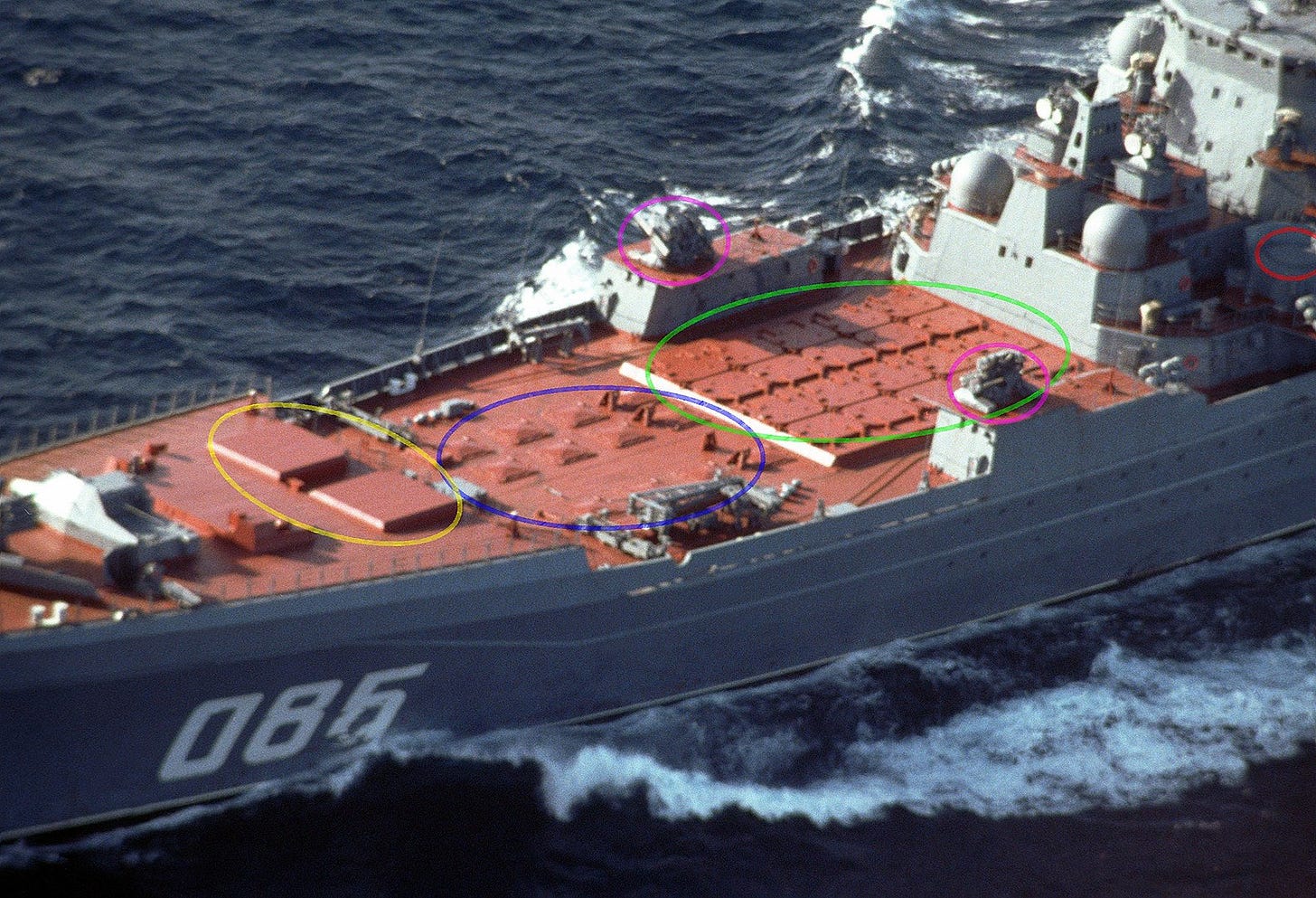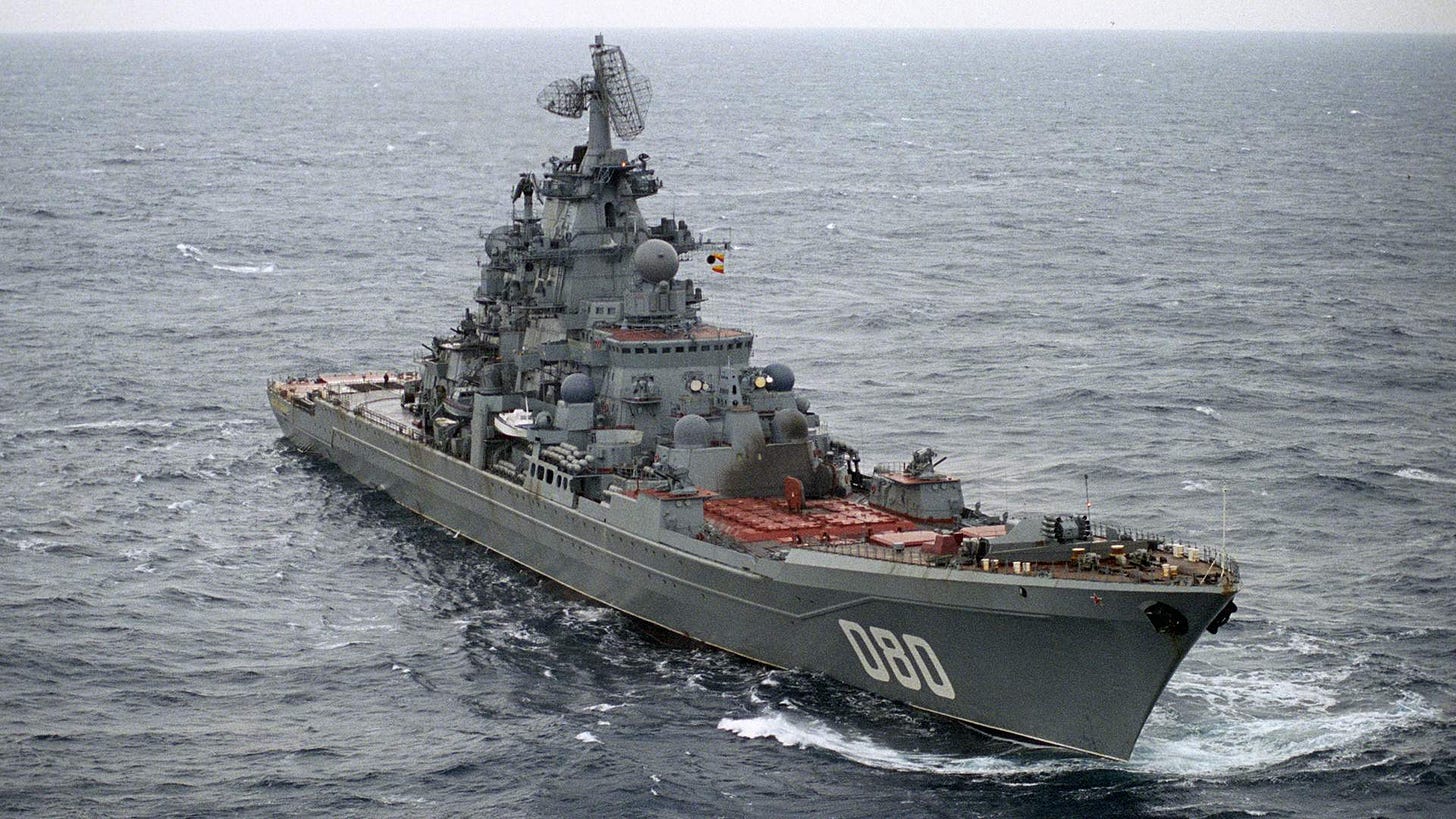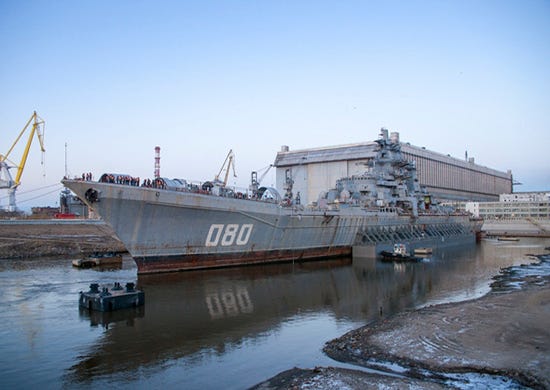Cold War Zombie: Russia Resurrects Its 28,000-Ton Nuclear Battlecruiser
Better watch out, comrades. The Russian navy is making a roaring comeback!
NOTE: Wow, the Russian trolls really showed up for this one… I’ve banned the first batch, but I’ve been forced to restrict comments to paid subscribers only. Apologies. As for the Putin-lovers, Убирайся к чёрту из Украины!
After 28 years stuck in drydock, the Russian Navy has finally shoved the Admiral Nakhimov, a Kirov-class nuclear battlecruiser, back into the White Sea for sea trials.
On paper, Nakhimov is terrifying. At 28,000 tons, it’s the largest surface combat ship afloat anywhere in the world, armed with more missiles than a small European country.
Russian state media practically drooled over its arsenal:
80 cruise missiles, including Kalibrs for land attack and Zircons that allegedly hit Mach 9 (on Tuesdays, after vodka).
96 navalized S-400 launch cells, giving it the theoretical power to swat entire squadrons of fighters, bombers, and even hypersonic weapons out of the sky from 400 kilometers away.
Enough vertical launch tubes overall, 174, to make a US Ticonderoga-class cruiser look like it came out of the “fun size” Halloween bag.
If all that works, the Admiral Nakhimov could function as a floating fortress, defending Arctic skies while throwing land-attack missiles at targets 2,500 kilometers away.
Russia is already calling it a “game changer.”
Of course, Russia also called the Moskva “unsinkable.” We know how that ended.
A Cruiser with a Nuclear Heart
The Admiral Nakhimov is not your average gray hunk of steel floating in the Arctic. At its core, literally, are two nuclear reactors that give it range and staying power most navies can only dream about.
These are not just big engines; they are the entire justification for keeping a 28,000-ton behemoth alive in the 21st century. Where conventional ships gulp diesel or gas like frat boys on spring break, the Nakhimov can cruise for years without refueling.
That kind of endurance is supposed to let Moscow project power across the Arctic, keeping NATO guessing about where the cruiser might turn up next.
But here’s the rub: running twin nuclear reactors at sea is one of the most maintenance-heavy jobs in naval engineering. Even the US Navy, with its industrial depth and safety culture, treats nuclear surface combatants as more trouble than they’re worth.
That’s why America retired its nuclear cruisers in the 1990s and kept only its carriers running on fission power. For Russia, with its history of cutting corners and duct-tape engineering, keeping the Nakhimov’s reactors humming safely is like asking a drunk juggler to handle live chainsaws.
The ship’s nuclear heart does, however, reveal what the Soviets had in mind when they built it back in the 1980s.

The Kirov class wasn’t designed to sit meekly in port. It was envisioned as a blue-water terror, capable of shadowing US carrier groups and operating independently in the far north. The nuclear propulsion wasn’t just about range; it was about prestige. Nothing said “superpower” quite like a cruiser that could circle the globe on atoms instead of diesel.
Fast-forward to today, and the symbolism remains, even if the strategic logic is outdated.
Yes, the ship can sprint around the Arctic at will, but modern warfare has shifted under its keel. Range and endurance mean less when drones, long-range missiles, and satellites can track your every move. In fact, being nuclear-powered in today’s environment makes the vessel more of a liability.
Any catastrophic failure, reactor leak, fire, or hull breach, would not only sink the ship but also spread radioactive fallout into the Arctic waters. That is not exactly the kind of “power projection” Russia wants associated with its navy.
And then there’s the unspoken question: who exactly is qualified to run those reactors after nearly three decades in drydock? Training nuclear crews is a long, exacting process.
If you’ve been following the state of Russian conscription lately, the thought of twenty-year-old conscripts babysitting twin reactors should keep Moscow’s admirals up at night.
In the end, the Admiral Nakhimov’s nuclear heart is both its trump card and its ticking time bomb. It gives the cruiser range and power few navies can match, but it also ties its fate to the competence of a navy that has shown a stunning ability to mismanage even basic systems.
Think of it as a Cold War muscle car with a nuclear engine under the hood; impressive to look at, terrifying if it actually has to drive down the highway.
Bragging Rights vs Reality
Here’s the sales pitch: the Nakhimov carries the equivalent of three S-400 battalions in missile tubes alone. At export value, that’s about $1.6 billion worth of air defense parked on one hull. Add in Kalibr cruise missiles, Oniks anti-ship weapons, and Zircon hypersonics, and you’ve got what looks like a strategic nightmare for NATO.
But here’s where the wheels fall off… Err, I mean anchor. Russia has a long and storied history of building spectacular warships that don’t actually work as advertised. The Kuznetsov aircraft carrier still sails with its own tugboat escort because it cannot be trusted not to break down mid-voyage.
The Moskva’s radars apparently never picked up the pair of Ukrainian Neptune missiles that sank it in 2022. And now, Russia wants us to believe this refurbished Cold War relic will function flawlessly as a modern battleship.
Spoiler: it won’t.
The Ghost of Mechanical Failures Past
When it comes to Russian naval engineering, the phrase “sea trials” might as well mean “waiting for the fire to start.” The Admiral Nakhimov isn’t just hauling two nuclear reactors into the Arctic; it’s dragging behind it a history of embarrassing, sometimes catastrophic failures that define the modern Russian Navy.
If any of this sounds familiar, it’s because Russia’s only aircraft carrier, the Admiral Kuznetsov, has already perfected this tragic comedy.
Remember Kuznetsov, the carrier so prone to breakdowns that it needed a dedicated tugboat escort? The one that turned heads not with its firepower but with its plumes of thick black smoke, looking more like a floating Soviet-era factory than a modern warship?
The one that suffered a series of humiliating accidents, including a dry dock sinking underneath it and a crane falling onto its deck?
Oh, and let’s not forget the spectacular fires. Because what’s a Russian naval project without an inferno to top things off?
The design of the carrier, with its reliance on a bow ramp for aircraft launches, stands in stark contrast to the catapult systems used by modern carriers like the Nimitz-class and the Ford-class.
These ramps are hard to miss. The UK’s carriers, Queen Elizabeth and Prince of Wales, use the bow ramps to launch fighters, and China’s first two carriers had them as well.
But there’s a problem with using the bow ramp as opposed to the U.S. steam-powered (or electromagnetic-powered on the Ford class) catapult system.
Because the aircraft gets no other assistance during takeoff, it must rely on only its own thrust and the bow ramp to lift it gracefully into the sky.
This means the bow ramp limits the speed and, consequently, the weight of the aircraft that can be launched.
This limitation has a direct impact on the tactical capabilities of the carrier, forcing aircraft to reduce their weapons loadout and fuel load.
This, in turn, limits the aircraft’s range and firepower.
Then there’s the Moskva, the Black Sea Fleet’s flagship until two Ukrainian Neptune missiles punched holes in it and sent it to the bottom in 2022. Ostensibly, the cruiser had advanced radars and defenses that should have detected and intercepted the incoming strike.
Instead, it became the largest warship sunk in combat since World War II. Russian naval systems look formidable on paper, but their integration and reliability often collapse the moment they meet an adversary who knows how to fight.
Even when they aren’t under fire, Russian warships struggle with the basics. Many hulls are plagued by corrosion from years of being parked in open-air storage with minimal upkeep.
Crews often work with outdated or jury-rigged systems that are more “Frankenstein fix” than reliable warfighting kit. That’s part of why it took nearly three decades to get the Nakhimov operational again. Every valve, every pipe, every circuit was a potential failure point, and with Russian industry hollowed out by corruption and sanctions, sourcing parts isn’t just difficult, it’s sometimes impossible.
And let’s not forget the people who are supposed to keep this nuclear juggernaut running. Poor morale, low pay, and a culture of cover-ups mean sailors are often more focused on hiding problems than fixing them.
Training accidents are frequent, safety protocols are loose suggestions, and conscripts with little technical background are sometimes shoved into positions that should require years of specialized training. In an environment like that, even a minor technical glitch can spiral into a full-blown disaster.
The Admiral Nakhimov might have a glossy refit, bristling with launch tubes and hypersonic promises, but its DNA is still Soviet-era engineering.
Combine that with a track record of neglect and a navy infamous for mechanical meltdowns, and you don’t get a reliable flagship… You get a floating time bomb that’s just waiting for the next headline-making failure.
Even if the ship does work, there’s another problem: the sailors. Russian naval morale is abysmal. The Black Sea Fleet has been humiliated repeatedly by Ukrainian drones, missiles, and even jet ski-sized USVs that sneak into Sevastopol and turn billion-dollar ships into reef material.
The Navy’s culture is toxic, promotions are political, and logistics are held together with duct tape and vodka. UK intelligence suggests that Russian sailors' morale is actually lower than that of frontline conscripts in Ukraine. That is to say… shocking low.
So yes, the Nakhimov may technically be the world’s largest and most heavily armed surface combatant. But at its core, it’s crewed by sailors who have watched their fleet get turned into scrap metal by a country with no navy.
That doesn’t build confidence; it builds fear. And fear does not fight well.
A Floating Target in a Drone War
The war in Ukraine has demonstrated that massive, expensive warships are sitting ducks in the age of cheap drones and long-range missiles. If Ukraine can sink the Moskva with domestically built Neptunes and turn Russian landing ships into artificial reefs with $250,000 naval drones, what chance does a lumbering 28,000-ton target really have?
Sure, the Nakhimov bristles with S-400s, but even the best air defense systems can be saturated. And Ukraine has made saturation its specialty.
For every Zircon missile on the Nakhimov, Ukraine can launch a swarm of cheap Shaheds, Magura USVs, or long-range kamikaze drones. A fortress at sea is still just a fortress. And fortresses fall.
The Admiral Nakhimov is impressive on paper. It’s a Cold War zombie brought back to life with nuclear engines, 174 missile tubes, and a fresh coat of paint.
But history and reality are working against it. Russia’s track record of mechanical failures, its catastrophic naval morale, and the rise of drone swarms mean the ship is more liability than asset.
If anything, its reappearance highlights the desperation of the Russian Navy. Moscow is raiding the museum shelves of its Cold War fleet to keep up appearances. And appearances are all it has left.
Because in the end, the Admiral Nakhimov is not the future of naval warfare.
It’s a relic, doomed to repeat the same story as the Kuznetsov and the Moskva: expensive, overhyped, and very likely to go down in flames.
Слава Україні!





Thank you for the detailed analysis. I would love Russia putting resources into this. The area of battleships ended at Pearl Harbor. And hasn’t been resurrected. Cursing in the artic for a year? They would run out of vodka before a month. But by all means, buil, buil build!
Very interesting analysis. Thank you. This ship will sink quite quickly I guess. And that will be something unforgettable. Maybe its crew will sell its engines and its armament before it can do any harm. Ouch. And lol too